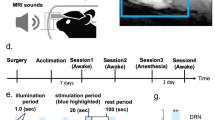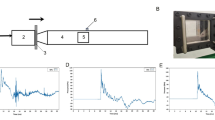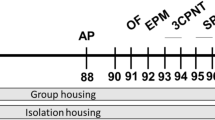Abstract
Major depression is a debilitating psychiatric disease that may be precipitated by a dysregulation of stress neurocircuitry caused by chronic or severe stress exposure. Moreover, hyperresponsivity to stressors correlates with depressed mood and may contribute to the etiology of major depression. The serotonergic dorsal raphe nucleus (DRN) is an important site in the neurocircuitry underlying behavioral responses to stressors, and is tightly regulated, in part, by a combination of intrinsic cell properties, autoinhibition, and GABAergic synaptic transmission. The stress-related neurotransmitter corticotropin-releasing factor (CRF) modulates DRN neuronal excitability and subsequent 5-HT release in the forebrain. Wistar Kyoto (WKY) rats exhibit exaggerated behavioral responses to stressors, that is, stress hyperresponsivity, and are considered an animal model of depression. To better understand the neurobiological basis of the stress hyperresponsivity, we used a combination of mRNA analysis and whole-cell electrophysiological techniques to measure differences in intrinsic activity and receptor response, in 5-HT- and non-5-HT-containing neurons of the DRN in WKY rats compared with Sprague-Dawley controls. In the WKY rat, there was a decrease in the neuronal excitability of 5-HT neurons coupled with decreased TPH2 production. Additionally, we found that CRF did not increase GABAergic activity in 5-HT neurons as is normally seen in 5-HT neurons of Sprague-Dawley controls. The CRF modulation of 5-HT DRN neurotransmission at the single-cell level is selectively disrupted in the WKY animal model of depression and may be one of the cellular correlates underlying depression.
Similar content being viewed by others
Log in or create a free account to read this content
Gain free access to this article, as well as selected content from this journal and more on nature.com
or
References
Abumaria N, Ribic A, Anacker C, Fuchs E, Flugge G (2008). Stress upregulates TPH1 but not TPH2 mRNA in the rat dorsal raphe nucleus: identification of two TPH2 mRNA splice variants. Cell Mol Neurobiol 28: 331–342.
Adell A, Casanovas JM, Artigas F (1997). Comparative study in the rat of the actions of different types of stress on the release of 5-HT in raphe nuclei and forebrain areas. Neuropharmacology 36: 735–741.
Beck SG, Pan YZ, Akanwa AC, Kirby LG (2004). Median and dorsal raphe neurons are not electrophysiologically identical. J Neurophysiol 91: 994–1005.
Clark MS, McDevitt RA, Hoplight BJ, Neumaier JF (2007). Chronic low dose ovine corticotropin releasing factor or urocortin II into the rostral dorsal raphe alters exploratory behavior and serotonergic gene expression in specific subregions of the dorsal raphe. Neuroscience 146: 1888–1905.
Conti LH, Youngblood KL, Printz MP, Foote SL (1997). Locus coeruleus electrophysiological activity and responsivity to corticotropin-releasing factor in inbred hypertensive and normotensive rats. Brain Res 774: 27–34.
Coppen AJ, Doogan DP (1988). Serotonin and its place in the pathogenesis of depression. J Clin Psychiatry 49 (Suppl): 4–11.
Crawford LK, Craige CP, Beck SG (2010). Increased intrinsic excitability of lateral wing serotonin neurons of the dorsal raphe: a mechanism for selective activation in stress circuits. J Neurophysiol 103: 2652–2663.
Day HE, Greenwood BN, Hammack SE, Watkins LR, Fleshner M, Maier SF et al (2004). Differential expression of 5HT-1A, alpha 1b adrenergic, CRF-R1, and CRF-R2 receptor mRNA in serotonergic, gamma-aminobutyric acidergic, and catecholaminergic cells of the rat dorsal raphe nucleus. J Comp Neurol 474: 364–378.
Deakin JF (1991). Depression and 5HT. Int Clin Psychopharmacol 6 (Suppl 3): 23–28.
Drake CL, Roehrs T, Roth T (2003). Insomnia causes, consequences, and therapeutics: an overview. Depress Anxiety 18: 163–176.
De La Garza R, Mahoney III JJ (2004). A distinct neurochemical profile in WKY rats at baseline and in response to acute stress: implications for animal models of anxiety and depression. Brain Res 1021: 209–218.
Dilts RP, Boadle-Biber MC (1995). Differential activation of the 5-hydroxytryptamine-containing neurons of the midbrain raphe of the rat in response to randomly presented inescapable sound. Neurosci Lett 199: 78–80.
Gervasoni D, Peyron C, Rampon C, Barbagli B, Chouvet G, Urbain N et al (2000). Role and origin of the GABAergic innervation of dorsal raphe serotonergic neurons. J Neurosci 20: 4217–4225.
Gizatullin R, Zaboli G, Jonsson EG, Asberg M, Leopardi R (2008). The tryptophan hydroxylase (TPH) 2 gene unlike TPH-1 exhibits no association with stress-induced depression. J Affect Disord 107: 175–179.
Graeff FG, Guimaraes FS, De Andrade TG, Deakin JF (1996). Role of 5-HT in stress, anxiety, and depression. Pharmacol Biochem Behav 54: 129–141.
Grahame-Smith DG (1989). Serotonin function in affective disorders. Acta Psychiatr Scand 350 (Suppl): 7–12.
Haddjeri N, Lucas G, Blier P (2000). Role of cholinergic and GABAergic systems in the feedback inhibition of dorsal raphe 5-HT neurons. NeuroReport 11: 3397–3401.
Hammack SE, Schmid MJ, LoPresti ML, Der-Avakian A, Pellymounter MA, Foster AC et al (2003). Corticotropin releasing hormone type 2 receptors in the dorsal raphe nucleus mediate the behavioral consequences of uncontrollable stress. J Neurosci 23: 1019–1025.
Henry B, Vale W, Markou A (2006). The effect of lateral septum corticotropin-releasing factor receptor 2 activation on anxiety is modulated by stress. J Neurosci 26: 9142–9152.
Homanics GE, DeLorey TM, Firestone LL, Quinlan JJ, Handforth A, Harrison NL et al (1997). Mice devoid of gamma-aminobutyrate type A receptor beta3 subunit have epilepsy, cleft palate, and hypersensitive behavior. Proc Natl Acad Sci USA 94: 4143–4148.
Kinney GG, Vogel GW, Feng P (1997). Decreased dorsal raphe nucleus neuronal activity in adult chloral hydrate anesthetized rats following neonatal clomipramine treatment: implications for endogenous depression. Brain Res 756: 68–75.
Kirby LG, Freeman-Daniels E, Lemos JC, Nunan JD, Lamy C, Akanwa A et al (2008). Corticotropin-releasing factor increases GABA synaptic activity and induces inward current in 5-hydroxytryptamine dorsal raphe neurons. J Neurosci 28: 12927–12937.
Kirby LG, Pan YZ, Freeman-Daniels E, Rani S, Nunan JD, Akanwa A et al (2007). Cellular effects of swim stress in the dorsal raphe nucleus. Psychoneuroendocrinology 32: 712–723.
Kirby LG, Rice KC, Valentino RJ (2000). Effects of corticotropin-releasing factor on neuronal activity in the serotonergic dorsal raphe nucleus. Neuropharmacology 22: 148–162.
Korpi ER, Sinkkonen ST (2006). GABA(A) receptor subtypes as targets for neuropsychiatric drug development. Pharmacol Ther 109: 12–32.
Lahmame A, del Arco C, Pazos A, Yritia M, Armario A (1997). Are Wistar-Kyoto rats a genetic animal model of depression resistant to antidepressants? Eur J Pharmacol 337: 115–123.
Land BB, Bruchas MR, Lemos JC, Xu M, Melief EJ, Chavkin C (2008). The dysphoric component of stress is encoded by activation of the dynorphin kappa-opioid system. J Neurosci 28: 407–414.
Lemos JC, Pan YZ, Ma X, Lamy C, Akanwa AC, Beck SG (2006). Selective 5-HT receptor inhibition of glutamatergic and GABAergic synaptic activity in the rat dorsal and median raphe. Eur J Neurosci 24: 3415–3430.
Leonard BE (2005). The HPA and immune axes in stress: the involvement of the serotonergic system. Eur Psychiatry 20 (Suppl 3): S302–S306.
Lopez-Rubalcava C, Lucki I (2000). Strain differences in the behavioral effects of antidepressant drugs in the rat forced swimming test. Neuropsychopharmacology 22: 191–199.
Lovenberg TW, Liaw CW, Grigoriadis DE, Clevenger W, Chalmers DT, De Souza EB et al (1995). Cloning and characterization of a functionally distinct corticotropin-releasing factor receptor subtype from rat brain. Proc Natl Acad Sci USA 92: 836–840.
Lowry CA, Hale MW, Evans AK, Heerkens J, Staub DR, Gasser PJ et al (2008). Serotonergic systems, anxiety, and affective disorder: focus on the dorsomedial part of the dorsal raphe nucleus. Ann NY Acad Sci 1148: 86–94.
Lukkes JL, Forster GL, Renner KJ, Summers CH (2008). Corticotropin-releasing factor 1 and 2 receptors in the dorsal raphe differentially affect serotonin release in the nucleus accumbens. Eur J Pharmacol 578: 185–193.
Maier SF, Watkins LR (2005). Stressor controllability and learned helplessness: the roles of the dorsal raphe nucleus, serotonin, and corticotropin-releasing factor. Neurosci Biobehav Rev 29: 829–841.
McEuen JG, Beck SG, Bale TL (2008). Failure to mount adaptive responses to stress results in dysregulation and cell death in the midbrain raphe. J Neurosci 28: 8169–8177.
Mohler H (2006). GABA(A) receptor diversity and pharmacology. Cell Tissue Res 326: 505–516.
Moss SJ, Smart TG (2001). Constructing inhibitory synapses. Nat Rev Neurosci 2: 240–250.
Nie Z, Schweitzer P, Roberts AJ, Madamba SG, Moore SD, Siggins GR (2004). Ethanol augments GABAergic transmission in the central amygdala via CRF1 receptors. Science 303: 1512–1514.
Nishikawa T, Scatton B (1983). Evidence for a GABAergic inhibitory influence on serotonergic neurons originating from the dorsal raphe. Brain Res 279: 325–329.
Nishikawa T, Scatton B (1984). The inhibitory GABAergic influence on striatal serotonergic neurons depends upon the habenulo-raphe pathways. Brain Res 304: 157–161.
Nishikawa T, Scatton B (1985). Inhibitory influence of GABA on central serotonergic transmission. Raphe nuclei as the neuroanatomical site of the GABAergic inhibition of cerebral serotonergic neurons. Brain Res 331: 91–103.
Pare AM, Pare WP, Kluczynski J (1999). Negative affect and voluntary alcohol consumption in Wistar-Kyoto (WKY) and Sprague-Dawley rats. Physiol Behav 67: 219–225.
Pare WP (1989a). ‘Behavioral despair’ test predicts stress ulcer in WKY rats. Physiol Behav 46: 483–487.
Pare WP (1989b). Stress ulcer susceptibility and depression in Wistar Kyoto (WKY) rats. Physiol Behav 46: 993–998.
Pare WP (1993). Passive-avoidance behavior in Wistar-Kyoto (WKY), Wistar, and Fischer-344 rats. Physiol Behav 54: 845–852.
Pare WP (1994a). Hyponeophagia in Wistar Kyoto (WKY) rats. Physiol Behav 55: 975–978.
Pare WP (1994b). Open field, learned helplessness, conditioned defensive burying, and forced-swim tests in WKY rats. Physiol Behav 55: 433–439.
Pare WP (2000). Investigatory behavior of a novel conspecific by Wistar Kyoto, Wistar and Sprague-Dawley rats. Brain Res Bull 53: 759–765.
Pare WP, Redei E (1993a). Depressive behavior and stress ulcer in Wistar Kyoto rats. J Physiol Paris 87: 229–238.
Pare WP, Redei E (1993b). Sex differences and stress response of WKY rats. Physiol Behav 54: 1179–1185.
Pare WP, Tejani-Butt SM (1996). Effect of stress on the behavior and 5-HT system in Sprague-Dawley and Wistar Kyoto rat strains. Integr Physiol Behav Sci 31: 112–121.
Pearson KA, Stephen A, Beck SG, Valentino RJ (2006). Identifying genes in monoamine nuclei that may determine stress vulnerability and depressive behavior in Wistar-Kyoto rats. Neuropsychopharmacology 31: 2449–2469.
Penington NJ, Kelly JP, Fox AP (1993). Whole-cell recordings of inwardly rectifying K+ currents activated by 5- HT1A receptors on dorsal raphe neurones of the adult rat. J Physiol 469: 387–405.
Pistis M, Muntoni AL, Gessa G, Diana M (1997). Effects of acute, chronic ethanol and withdrawal on dorsal raphe neurons: electrophysiological studies. Neuroscience 79: 171–176.
Pollier F, Sarre S, Aguerre S, Ebinger G, Mormede P, Michotte Y et al (2000). Serotonin reuptake inhibition by citalopram in rat strains differing for their emotionality. Neuropsychopharmacology 22: 64–76.
Price ML, Curtis AL, Kirby LG, Valentino RJ, Lucki I (1998). Effects of corticotropin-releasing factor on brain serotonergic activity. Neuropharmacology 18: 492–502.
Price ML, Kirby LG, Valentino RJ, Lucki I (2002). Evidence for corticotropin-releasing factor regulation of serotonin in the lateral septum during acute swim stress: adaptation produced by repeated swimming. Psychopharmacology (Berl) 162: 406–414.
Price ML, Lucki I (2001). Regulation of serotonin release in the lateral septum and striatum by corticotropin-releasing factor. J Neurosci 21: 2833–2841.
Ramadan E, Fu Z, Losi G, Homanics GE, Neale JH, Vicini S (2003). GABA(A) receptor beta3 subunit deletion decreases alpha2/3 subunits and IPSC duration. J Neurophysiol 89: 128–134.
Richardson-Jones JW, Craige CP, Guiard BP, Stephen A, Metzger KL, Kung HF et al (2010). 5-HT1A autoreceptor levels determine vulnerability to stress and response to antidepressants. Neuron 65: 40–52.
Rittenhouse PA, Lopez-Rubalcava C, Stanwood GD, Lucki I (2002). Amplified behavioral and endocrine responses to forced swim stress in the Wistar-Kyoto rat. Psychoneuroendocrinology 27: 303–318.
Robinson DS, Alms DR, Shrotriya RC, Messina M, Wickramaratne P (1989). Serotonergic anxiolytics and treatment of depression. Psychopathology 22 (Suppl 1): 27–36.
Roche M, Commons KG, Peoples A, Valentino RJ (2003). Circuitry underlying regulation of the serotonergic system by swim stress. J Neurosci 23: 970–977.
Ruhe HG, Mason NS, Schene AH (2007). Mood is indirectly related to serotonin, norepinephrine and dopamine levels in humans: a meta-analysis of monoamine depletion studies. Mol Psychiatry 12: 331–359.
Schmidt MV, Sterlemann V, Muller MB (2008). Chronic stress and individual vulnerability. Ann NY Acad Sci 1148: 174–183.
Scholl JL, Renner KJ, Forster GL, Tejani-Butt S (2010). Central monoamine levels differ between rat strains used in studies of depressive behavior. Brain Res 1355: 41–51.
Shishkina GT, Kalinina TS, Dygalo NN (2008). Serotonergic changes produced by repeated exposure to forced swimming: correlation with behavior. Ann NY Acad Sci 1148: 148–153.
Stockmeier CA (1997). Neurobiology of serotonin in depression and suicide. Ann NY Acad Sci 836: 220–232.
Tao R, Auerbach SB (2002). GABAergic and glutamatergic afferents in the dorsal raphe nucleus mediate morphine-induced increases in serotonin efflux in the rat central nervous system. J Pharmacol Exp Ther 303: 704–710.
Tejani-Butt S, Kluczynski J, Pare WP (2003). Strain-dependent modification of behavior following antidepressant treatment. Prog Neuropsychopharmacol Biol Psychiatry 27: 7–14.
Tejani-Butt SM, Pare WP, Yang J (1994). Effect of repeated novel stressors on depressive behavior and brain norepinephrine receptor system in Sprague-Dawley and Wistar Kyoto (WKY) rats. Brain Res 649: 27–35.
Walker E, Mittal V, Tessner K (2008). Stress and the hypothalamic pituitary adrenal axis in the developmental course of schizophrenia. Annu Rev Clin Psychol 4: 189–216.
Wang B, You ZB, Rice KC, Wise RA (2007). Stress-induced relapse to cocaine seeking: roles for the CRF(2) receptor and CRF-binding protein in the ventral tegmental area of the rat. Psychopharmacology (Berl) 193: 283–294.
Waselus M, Nazzaro C, Valentino RJ, Van Bockstaele EJ (2009). Stress-induced redistribution of corticotropin-releasing factor receptor subtypes in the dorsal raphe nucleus. Biol Psychiatry 66: 76–83.
Will CC, Aird F, Redei EE (2003). Selectively bred Wistar-Kyoto rats: an animal model of depression and hyper-responsiveness to antidepressants. Mol Psychiatry 8: 925–932.
Zafar HM, Pare WP, Tejani-Butt SM (1997). Effect of acute or repeated stress on behavior and brain norepinephrine system in Wistar-Kyoto (WKY) rats. Brain Res Bull 44: 289–295.
Acknowledgements
We thank Dr Jean Rivier of the Clayton Foundation Laboratories for Peptide Biology at The Salk Institute for his generous donations of oCRF and Ucn II for use in these studies. We also thank Abigail Schindler for her useful suggestions on the manuscript. This work was supported by grants from a Young Investigator Award from the National Alliance for Research on Schizophrenia and Depression (NARSAD) and the National Institute of Mental Health (MH 63301 and DA 20126) to LGK and NIMH (MH 60773) and the Office of Naval Research (N00014-03-1-0311) grants issued to Dr Beck.
Author information
Authors and Affiliations
Corresponding author
Ethics declarations
Competing interests
The authors declare no conflict of interest.
Additional information
Supplementary Information accompanies the paper on the Neuropsychopharmacology website
Rights and permissions
About this article
Cite this article
Lemos, J., Zhang, G., Walsh, T. et al. Stress-Hyperresponsive WKY Rats Demonstrate Depressed Dorsal Raphe Neuronal Excitability and Dysregulated CRF-Mediated Responses. Neuropsychopharmacol 36, 721–734 (2011). https://doi.org/10.1038/npp.2010.200
Received:
Revised:
Accepted:
Published:
Issue date:
DOI: https://doi.org/10.1038/npp.2010.200
Keywords
This article is cited by
-
Preclinical models of treatment-resistant depression: challenges and perspectives
Pharmacological Reports (2023)
-
Instrumental conditioning for food reinforcement in the spontaneously hypertensive rat model of attention deficit hyperactivity disorder
BMC Research Notes (2017)
-
5-HT1A Autoreceptors in the Dorsal Raphe Nucleus Convey Vulnerability to Compulsive Cocaine Seeking
Neuropsychopharmacology (2016)
-
Functional Alterations in the Dorsal Raphe Nucleus Following Acute and Chronic Ethanol Exposure
Neuropsychopharmacology (2015)
-
Localisation and stress-induced plasticity of GABAA receptor subunits within the cellular networks of the mouse dorsal raphe nucleus
Brain Structure and Function (2015)



